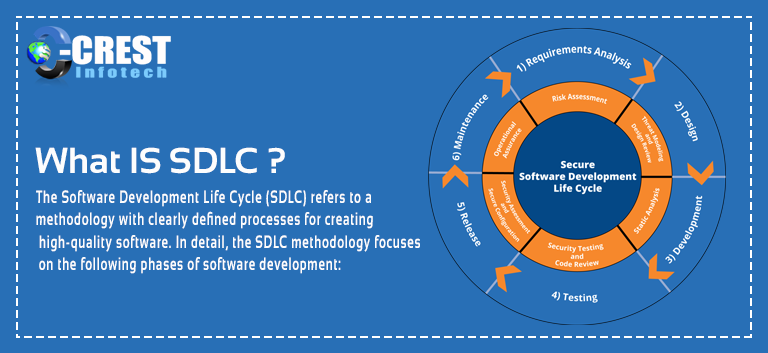The Life Cycle of Software Development (SDLC) refers to a methodology with clearly defined processes for high-quality software creation. The SDLC methodology concentrates in detail on the following stages of software development:
- Analysis of requirements
- Planning
- Design of software, such as architectural design
- Developing software
- Testing
- The Deployment
What is the life cycle for software development?
SDLC, or the Life Cycle of Software Development, is a process that produces the highest quality and lowest cost software in the shortest time possible. SDLC offers a well-structured phase flow that allows an organisation to produce high-quality software that is well-tested and ready for production use quickly.
As explained in the introduction, the SDLC includes six stages. The waterfall model, spiral model, and Agile model include popular SDLC models. So how is the Life Cycle of Software Development working? As explained in the introduction, the SDLC includes six stages. The waterfall model, spiral model, and agile model include popular SDLC models.
So how is the Life Cycle of Software Development working?
How the SDLC functions
SDLC operates by reducing software development costs while improving quality and shortening output time simultaneously. By pursuing a strategy that avoids the usual drawbacks of software development programmes, SDLC achieves these seemingly divergent objectives. This plan starts with the assessment of existing systems for shortcomings.
Next, it determines the new system’s specifications. Through the stages of research, preparation, design, creation, testing, and implementation, it then creates the programme. SLDC can eliminate redundant rework and after-the-fact fixes by anticipating costly errors such as failing to ask the end-user or client for feedback.
It’s also important to know that the testing phase has a strong focus. Since the SDLC is a repetitive methodology, at every cycle you must ensure code quality. Many organizations tend to spend little effort on testing, while a greater focus on testing can save them a lot of work, time, and money. Be clever and write the right kinds of tests
Next, let’s explore the different stages of the Software Development Life Cycle
Good Practices and Phases
Following SDLC’s best practises and/or phases ensures that the process operates smoothly, reliably and productively.
- Identify the existing problems
What are the issues at present? “This phase of the SDLC means that all stakeholders, including customers, salespeople, industry experts, and programmers, receive input. With enhancement as the target, discover the strengths and limitations of the new system.
- The plan
“What are we going to want? The team defines the costs and resources needed for the implementation of the evaluated specifications in this stage of the SDLC. It also outlines the risks involved and proposes sub-plans to minimise those risks.In other words, with the lowest risk in mind, the team can assess the project’s viability and how they can effectively execute the project.
- Design
“What are we going to want? The team defines the costs and resources needed for the implementation of the evaluated specifications in this stage of the SDLC. It also outlines the risks involved and proposes sub-plans to minimise those risks.In other words, with the lowest risk in mind, the team can assess the project’s viability and how they can effectively execute the project. Failure at this point would almost inevitably lead to cost overruns at best and the project’s complete failure at worst.
- Build Up
“What we want, let’s create. “The actual creation begins at this point. It’s important to stick to the accepted blueprint for any developer. Also, make sure you have proper rules about the style and procedures of the code in place.
- Test Code
Have we gotten what we want? “We test for defects and deficiencies at this point. We fix those problems until the original requirements are met by the product. In short, we want to verify whether the code meets the requirements specified.
- Deployment Of Applications
“Let’s begin to use what we have. “The purpose at this point is to deploy the programme in the production environment in order to enable consumers to start using the product. Many companies, however, prefer to move the product across various environments of implementation, such as a testing or staging area. This enables every stakeholder to play with the item safely before releasing it to the market. Besides, before releasing the product, this allows any final errors to be caught.
The SDLC Benefits
SDLC performed correctly will allow for the highest degree of monitoring and reporting of management. Developers understand what and why they need to construct. All parties agree on the target in advance and see a specific strategy for achieving the goal. The costs and services needed are known by all.
A SDLC implementation can transform some pitfalls into more of a roadblock to progress than an instrument that helps us. Failure to take the interests of clients and other users and stakeholders into account will lead to a weak understanding of the specifications of the system at the outset. SDLC’s advantages only occur if the strategy is implemented faithfully.
You can also Hire Dedicated Developer and Hire Dedicated Designers. Contact Crest Infotech to know more about Dedicated Development and Designing services in Details.
